Google Earth Engine as Multi-Sensor Open-Source Tool for Monitoring Stream Flow in the Transboundary River Basin: Doosti River Dam
Abstract
1. Introduction
- (1)
- (2)
- To analyse the causes of surface water variation in the Doosti Dam reservoir and identify the trend;
- (3)
- To assess and map spatiotemporal distribution and the overall trends of the hydro-climatological condition using several satellite gridded datasets for the last 20 years and identify the possible factors causing the trend.
2. Materials and Methods
2.1. Study Region
2.2. Datasets
2.2.1. Ground Measurements
2.2.2. Satellite Data
MODIS Data
Landsat Images
2.3. Methods
2.3.1. Mann–Kendall Trend and Sen’s Slope Test
2.3.2. Descriptive Statistics
3. Results
3.1. Temporal Pattern of Different Hydroclimatic Factors
3.2. Spatiotemporal Distribution of Rainfall in the Doosti Dam Basin (2004–2021)
3.3. Spatio-Temporal Distribution of Temperature (LST) in the Doosti Dam Basin (2004–2021)
3.4. Spatio-Temporal Distribution Annual Evapotranspiration from MODIS in the Doosti Dam’s Basin (2004–2021)
3.5. Spatio-Temporal Distribution Annual Snow Cover Duration from MODIS in the Doosti Dam’s Basin (2004–2021)
3.6. Spatio-Temporal Distribution for Summer Irrigated Cultivated Areas in the Doosti Dam Basin (2001–2021)
3.7. Spatio-Temporal Distribution Winter Irrigated Cultivated Areas in the Doosti Dam Basin’s (2001–2020)
4. Discussion
5. Conclusions
- (1)
- The study showed how well multisensory satellite data can be used to predict hydrometeorological spatiotemporal trends, especially in transboundary high elevation areas when accessing station-observed data is a major challenge. It demonstrated that, for most variables, these trends largely relied on elevation. This statistically upward trend was seen in rainfall, evapotranspiration, and lower temperature during the years 2004 to 2021, but did not have a remarkable effect on snow cover duration.
- (2)
- This study was focused on understanding how the irrigated cultivated lands responded to different hydroclimatic variables. Because it is a transboundary region, has diverse topography and climate change conditions, the monitoring of the irrigated lands was difficult. Elevation had a significant influence on the climate and the Doosti Dam, situated at a lower elevation, was employed to comprehend the long-term spatiotemporal variability of the irrigated areas and related climatic and hydrological causes. NDVI derived from MODIS indicated the strong correlation between the NDVI and precipitation in the winter.
- (3)
- Additionally, the findings demonstrate that GEE is an effective method for compiling and establishing the spatiotemporal fluctuations in various variables and that remotely sensed data products consistently represent ground observations in remote transboundary areas. It is anticipated that the socio-ecological system in this transboundary area would decline owing to unsustainable water management which will negatively affect the conditions of the residents. It is important to consider the environmental right of the lakes to improve the conditions in the transboundary river basin. GEE’s potential has not yet been fully realised, despite the fact that it has gradually evolved into a platform for remote sensing research. With the help of GEE, this study offers a rapid and feasible method for determining spatiotemporal climatic trends. The methodology can be easily applied to other areas with comparable issues when combined with the tools made available by GEE. The results of this study can aid in the management of water resources and the preservation of the ecological environment in the Doosti Dam’s basin and other transboundary regions.
- (4)
- In an area characterised by a complicated set of interactions between precipitation, evapotranspiration, temperature, NDVI, snow cover, lake area and discharge, the overall findings of this study could guide water resource management strategies. Future research should take these elements into account in order to provide a full forecast of the spatiotemporal climatic dynamics of transboundary areas, especially in light of the current period of rapid climate change (both natural and anthropogenic).
Author Contributions
Funding
Data Availability Statement
Acknowledgments
Conflicts of Interest
References
- Mianabadi, H.; Alioghli, S.; Morid, S. Quantitative evaluation of ‘No-harm’rule in international transboundary water law in the Helmand River Basin. J. Hydrol. 2021, 599, 126368. [Google Scholar] [CrossRef]
- Al-Faraj, F.A.; Scholz, M. Assessment of temporal hydrologic anomalies coupled with drought impact for a transboundary river flow regime: The Diyala watershed case study. J. Hydrol. 2014, 517, 64–73. [Google Scholar] [CrossRef]
- Wu, J.; Liu, Z.; Yao, H.; Chen, X.; Chen, X.; Zheng, Y.; He, Y. Impacts of reservoir operations on multi-scale correlations between hydrological drought and meteorological drought. J. Hydrol. 2018, 563, 726–736. [Google Scholar] [CrossRef]
- Gao, H.; Birkett, C.; Lettenmaier, D.P. Global monitoring of large reservoir storage from satellite remote sensing. Water Resour. Res. 2012, 48, 1–12. [Google Scholar] [CrossRef]
- Moreno, M.; Bertolín, C.; Ortiz, P.; Ortiz, R. Satellite product to map drought and extreme precipitation trend in Andalusia, Spain: A novel method to assess heritage landscapes at risk. Int. J. Appl. Earth Obs. Geoinf. 2022, 110, 102810. [Google Scholar] [CrossRef]
- Pakdel Khasmakhi, H.; Vazifedoust, M.; Marofi, S.; Tizro, A.T. Simulation of river discharge in ungauged catchments by forcing GLDAS products to a hydrological model (a case study: Polroud basin, Iran). Water Supply 2020, 20, 277–286. [Google Scholar] [CrossRef]
- Sadeghi Loyeh, N.; Massah Bavani, A. Daily maximum runoff frequency analysis under non-stationary conditions due to climate change in the future period: Case study Ghareh Sou Basin. J. Water Clim. Chang. 2021, 12, 1910–1929. [Google Scholar] [CrossRef]
- Erazo, B.; Bourrel, L.; Frappart, F.; Chimborazo, O.; Labat, D.; Dominguez-Granda, L.; Matamoros, D.; Mejia, R. Validation of satellite estimates (Tropical Rainfall Measuring Mission, TRMM) for rainfall variability over the Pacific slope and Coast of Ecuador. Water 2018, 10, 213. [Google Scholar] [CrossRef]
- Ma, L.; Liu, Y.; Zhang, X.; Ye, Y.; Yin, G.; Johnson, B.A. Deep learning in remote sensing applications: A meta-analysis and review. ISPRS J. Photogramm. Remote Sens. 2019, 152, 166–177. [Google Scholar] [CrossRef]
- Ellsäßer, F.; Röll, A.; Stiegler, C.; Hölscher, D. Introducing QWaterModel, a QGIS plugin for predicting evapotranspiration from land surface temperatures. Environ. Model. Softw. 2020, 130, 104739. [Google Scholar] [CrossRef]
- Zaki, A.; Buchori, I.; Sejati, A.W.; Liu, Y. An object-based image analysis in QGIS for image classification and assessment of coastal spatial planning. Egypt. J. Remote Sens. Space Sci. 2022, 25, 349–359. [Google Scholar] [CrossRef]
- Wang, C.; Jia, M.; Chen, N.; Wang, W. Long-term surface water dynamics analysis based on Landsat imagery and the Google Earth Engine platform: A case study in the middle Yangtze River Basin. Remote Sens. 2018, 10, 1635. [Google Scholar] [CrossRef]
- Dastour, H.; Ghaderpour, E.; Hassan, Q.K. A combined approach for monitoring monthly surface water/ice dynamics of Lesser Slave Lake via Earth observation data. IEEE J. Sel. Top. Appl. Earth Obs. Remote Sens. 2022, 15, 6402–6417. [Google Scholar] [CrossRef]
- Gorelick, N.; Hancher, M.; Dixon, M.; Ilyushchenko, S.; Thau, D.; Moore, R. Google Earth Engine: Planetary-scale geospatial analysis for everyone. Remote Sens. Environ. 2017, 202, 18–27. [Google Scholar] [CrossRef]
- Tamiminia, H.; Salehi, B.; Mahdianpari, M.; Quackenbush, L.; Adeli, S.; Brisco, B. Google Earth Engine for geo-big data applications: A meta-analysis and systematic review. ISPRS J. Photogramm. Remote Sens. 2020, 164, 152–170. [Google Scholar] [CrossRef]
- Google Developers: Get Started with Earth Engine. Available online: https://developers.google.com/earth-engine/getstarted (accessed on 21 September 2022).
- Mozafari, M.; Raeisi, E.; Zare, M. Water leakage paths in the Doosti Dam, Turkmenistan and Iran. Environ. Earth Sci. 2012, 65, 103–117. [Google Scholar] [CrossRef]
- Majidi, M.; Alizadeh, A.; Farid, A.; Vazifedoust, M. Estimating evaporation from lakes and reservoirs under limited data condition in a semi-arid region. Water Resour. Manag. 2015, 29, 3711–3733. [Google Scholar] [CrossRef]
- Rezaei Sekkeravani, D.; Chenari, S.; Faraji, M.; Dashti, s.F. Study the Iranian hydropolitical challenges in the shared drainage basins with Neighboring Countries. IOSR J. Humanit. Soc. Sci. IOSR-JHSS 2018, 23, 67–78. [Google Scholar] [CrossRef]
- Akbari, M.; Mirchi, A.; Roozbahani, A.; Gafurov, A.; Kløve, B.; Haghighi, A.T. Desiccation of the transboundary Hamun Lakes between Iran and Afghanistan in response to hydro-climatic droughts and anthropogenic activities. J. Great Lakes Res. 2022, 48, 876–889. [Google Scholar] [CrossRef]
- Salomon, J.; Hodges, J.C.; Friedl, M.; Schaaf, C.; Strahler, A.; Gao, F.; Schneider, A.; Zhang, X.; El Saleous, N.; Wolfe, R.E. Global land-water mask derived from MODIS Nadir BRDF-adjusted reflectances (NBAR) and the MODIS land cover algorithm. In Proceedings of the IGARSS 2004. 2004 IEEE International Geoscience and Remote Sensing Symposium, Anchorage, AK, USA, 20–24 September 2004. [Google Scholar]
- Li, L.; Vrieling, A.; Skidmore, A.; Wang, T.; Turak, E. Monitoring the dynamics of surface water fraction from MODIS time series in a Mediterranean environment. Int. J. Appl. Earth Obs. Geoinf. 2018, 66, 135–145. [Google Scholar] [CrossRef]
- Carroll, M.; Wooten, M.; DiMiceli, C.; Sohlberg, R.; Kelly, M. Quantifying surface water dynamics at 30 m spatial resolution in the North American high northern latitudes 1991–2011. Remote Sens. 2016, 8, 622. [Google Scholar] [CrossRef]
- Pekel, J.-F.; Cottam, A.; Gorelick, N.; Belward, A.S. High-resolution mapping of global surface water and its long-term changes. Nature 2016, 540, 418–422. [Google Scholar] [CrossRef] [PubMed]
- Tulbure, M.G.; Broich, M.; Stehman, S.V.; Kommareddy, A. Surface water extent dynamics from three decades of seasonally continuous Landsat time series at subcontinental scale in a semi-arid region. Remote Sens. Environ. 2016, 178, 142–157. [Google Scholar] [CrossRef]
- Shen, G.; Fu, W.; Guo, H.; Liao, J. Water Body Mapping Using Long Time Series Sentinel-1 SAR Data in Poyang Lake. Water 2022, 14, 1902. [Google Scholar] [CrossRef]
- Surface Water Changes. (1985–2016). Available online: http://aqua-monitor.deltares.nl (accessed on 21 September 2022).
- Donchyts, G.; Baart, F.; Winsemius, H.; Gorelick, N.; Kwadijk, J.; Van De Giesen, N. Earth’s surface water change over the past 30 years. Nat. Clim. Chang. 2016, 6, 810–813. [Google Scholar] [CrossRef]
- Gholizadeh Sarabi, S.; Rahnama, M.R. From self-sufficient provision of water and energy to regenerative urban development and sustainability: Exploring the potentials in Mashhad City, Iran. J. Environ. Plan. Manag. 2021, 64, 2459–2480. [Google Scholar] [CrossRef]
- Mosaffa, H.; Sadeghi, M.; Hayatbini, N.; Afzali Gorooh, V.; Akbari Asanjan, A.; Nguyen, P.; Sorooshian, S. Spatiotemporal variations of precipitation over Iran using the high-resolution and nearly four decades satellite-based PERSIANN-CDR dataset. Remote Sens. 2020, 12, 1584. [Google Scholar] [CrossRef]
- Raziei, T.; Daryabari, J.; Bordi, I.; Modarres, R.; Pereira, L.S. Spatial patterns and temporal trends of daily precipitation indices in Iran. Clim. Chang. 2014, 124, 239–253. [Google Scholar] [CrossRef]
- Luo, R.; Yuan, Q.; Yue, L.; Shi, X. Monitoring recent lake variations under climate change around the Altai mountains using multimission satellite data. IEEE J. Sel. Top. Appl. Earth Obs. Remote Sens. 2020, 14, 1374–1388. [Google Scholar] [CrossRef]
- Veh, G.; Korup, O.; Roessner, S.; Walz, A. Detecting Himalayan glacial lake outburst floods from Landsat time series. Remote Sens. Environ. 2018, 207, 84–97. [Google Scholar] [CrossRef]
- Ma, Y.; Xu, N.; Sun, J.; Wang, X.H.; Yang, F.; Li, S. Estimating water levels and volumes of lakes dated back to the 1980s using Landsat imagery and photon-counting lidar datasets. Remote Sens. Environ. 2019, 232, 111287. [Google Scholar] [CrossRef]
- Lu, S.; Ouyang, N.; Wu, B.; Wei, Y.; Tesemma, Z. Lake water volume calculation with time series remote-sensing images. Int. J. Remote Sens. 2013, 34, 7962–7973. [Google Scholar] [CrossRef]
- Moghim, S. Impact of climate variation on hydrometeorology in Iran. Glob. Planet. Chang. 2018, 170, 93–105. [Google Scholar] [CrossRef]
- Malaekeh, S.; Safaie, A.; Shiva, L.; Tabari, H. Spatio-temporal variation of hydro-climatic variables and extreme indices over Iran based on reanalysis data. Stoch. Environ. Res. Risk Assess. 2022, 1–28. [Google Scholar] [CrossRef]
- Arnell, N.W.; Gosling, S.N. The impacts of climate change on river flow regimes at the global scale. J. Hydrol. 2013, 486, 351–364. [Google Scholar] [CrossRef]
- Blum, J.R.; Eichhorn, A.; Smith, S.; Sterle-Contala, M.; Cooperstock, J.R. Real-time emergency response: Improved management of real-time information during crisis situations. J. Multimodal User Interfaces 2014, 8, 161–173. [Google Scholar] [CrossRef]
- Irwin, K.; Beaulne, D.; Braun, A.; Fotopoulos, G. Fusion of SAR, optical imagery and airborne LiDAR for surface water detection. Remote Sens. 2017, 9, 890. [Google Scholar] [CrossRef]
- Li, Z.-L.; Tang, B.-H.; Wu, H.; Ren, H.; Yan, G.; Wan, Z.; Trigo, I.F.; Sobrino, J.A. Satellite-derived land surface temperature: Current status and perspectives. Remote Sens. Environ. 2013, 131, 14–37. [Google Scholar] [CrossRef]
- Li, S.; Yu, Y.; Sun, D.; Tarpley, D.; Zhan, X.; Chiu, L. Evaluation of 10 year AQUA/MODIS land surface temperature with SURFRAD observations. Int. J. Remote Sens. 2014, 35, 830–856. [Google Scholar] [CrossRef]
- Wan, Z. Collection-5 MODIS Land Surface Temperature Products Users’ Guide. ICESS, University of California, Santa Barbara. 2007. Available online: https://www.cen.uni-hamburg.de/en/icdc/data/land/docs-land/modis-lst-products-user-guide-c5.pdf (accessed on 21 September 2022).
- MOD11A1. Available online: https://developers.google.com/earth-engine/datasets/catalog/MODIS_061_MOD11A1 (accessed on 21 September 2022).
- Dietz, A.J.; Kuenzer, C.; Gessner, U.; Dech, S. Remote sensing of snow–a review of available methods. Int. J. Remote Sens. 2012, 33, 4094–4134. [Google Scholar] [CrossRef]
- MOD10A1. Available online: https://developers.google.com/earth-engine/datasets/catalog/MODIS_006_MOD10A1 (accessed on 21 September 2022).
- MOD09GQ. Available online: https://developers.google.com/earth-engine/datasets/catalog/MODIS_061_MOD09GQ (accessed on 21 September 2022).
- Running, S.; Mu, Q.; Zhao, M. MOD16A2 MODIS/Terra Net Evapotranspiration 8-day L4 global 500m SIN Grid V006 [Data Set]. NASA EOSDIS Land Processes DAAC; 2017. Available online: https://ladsweb.modaps.eosdis.nasa.gov/missions-and-measurements/products/MOD16A2 (accessed on 21 September 2022).
- Tian, H.; Li, W.; Wu, M.; Huang, N.; Li, G.; Li, X.; Niu, Z. Dynamic monitoring of the largest freshwater lake in China using a new water index derived from high spatiotemporal resolution Sentinel-1A data. Remote Sens. 2017, 9, 521. [Google Scholar] [CrossRef]
- Plug, L.J.; Walls, C.; Scott, B. Tundra lake changes from 1978 to 2001 on the Tuktoyaktuk Peninsula, Western Canadian Arctic. Geophys. Res. Lett. 2008, 35. [Google Scholar] [CrossRef]
- Tao, S.; Fang, J.; Zhao, X.; Zhao, S.; Shen, H.; Hu, H.; Tang, Z.; Wang, Z.; Guo, Q. Rapid loss of lakes on the Mongolian Plateau. Proc. Natl. Acad. Sci. USA 2015, 112, 2281–2286. [Google Scholar] [CrossRef] [PubMed]
- Du, Z.; Bin, L.; Ling, F.; Li, W.; Tian, W.; Wang, H.; Gui, Y.; Sun, B.; Zhang, X. Estimating surface water area changes using time-series Landsat data in the Qingjiang River Basin, China. J. Appl. Remote Sens. 2012, 6, 063609. [Google Scholar] [CrossRef]
- Xu, H. Modification of normalised difference water index (NDWI) to enhance open water features in remotely sensed imagery. Int. J. Remote Sensing. 2006, 27, 3025–3033. [Google Scholar] [CrossRef]
- Pham-Duc, B.; Prigent, C.; Aires, F. Surface water monitoring within Cambodia and the Vietnamese Mekong Delta over a year, with Sentinel-1 SAR observations. Water 2017, 9, 366. [Google Scholar] [CrossRef]
- Li, W.; Du, Z.; Ling, F.; Zhou, D.; Wang, H.; Gui, Y.; Sun, B.; Zhang, X. A comparison of land surface water mapping using the normalized difference water index from TM, ETM+ and ALI. Remote Sens. 2013, 5, 5530–5549. [Google Scholar] [CrossRef]
- Gorelick, N.; Clinton, N. Multitemporal Supervised Classification Using Google Earth Engine. In Proceedings of the AGU Fall Meeting, Washington, DC, USA, 10–14 December 2018. [Google Scholar]
- Banerjee, A.; Chen, R.; Meadows, M.E.; Singh, R.; Mal, S.; Sengupta, D. An analysis of long-term rainfall trends and variability in the uttarakhand himalaya using Google Earth Engine. Remote Sens. 2020, 12, 709. [Google Scholar] [CrossRef]
- Mann, H.B. Nonparametric tests against trend. Econom. J. Econom. Soc. 1945, 13, 245–259. [Google Scholar] [CrossRef]
- Kendall, M. Rank Correlation Methods, 4th ed.; Charles Griffin: London, UK, 1975. [Google Scholar]
- Zolghadr-Asli, B.; Bozorg-Haddad, O.; Sarzaeim, P.; Chu, X. Investigating the variability of GCMs’ simulations using time series analysis. J. Water Clim. Change 2019, 10, 449–463. [Google Scholar] [CrossRef]
- Tabari, H.; Marofi, S.; Aeini, A.; Talaee, P.H.; Mohammadi, K. Trend analysis of reference evapotranspiration in the western half of Iran. Agric. For. Meteorol. 2011, 151, 128–136. [Google Scholar] [CrossRef]
- Gholami, H.; Moradi, Y.; Lotfirad, M.; Gandomi, M.A.; Bazgir, N.; Shokrian Hajibehzad, M. Detection of abrupt shift and non-parametric analyses of trends in runoff time series in the Dez river basin. Water Supply 2022, 22, 1216–1230. [Google Scholar] [CrossRef]
- Sen, P.K. Estimates of the regression coefficient based on Kendall’s tau. J. Am. Stat. Assoc. 1968, 63, 1379–1389. [Google Scholar] [CrossRef]
- Banerjee, A.; Chen, R.; Meadows, M.E.; Sengupta, D.; Pathak, S.; Xia, Z.; Mal, S. Tracking 21st century climate dynamics of the Third Pole: An analysis of topo-climate impacts on snow cover in the central Himalaya using Google Earth Engine. Int. J. Appl. Earth Obs. Geoinformation. 2021, 103, 102490. [Google Scholar] [CrossRef]
- Tabari, H.; Somee, B.S.; Zadeh, M.R. Testing for long-term trends in climatic variables in Iran. Atmos. Res. 2011, 100, 132–140. [Google Scholar] [CrossRef]
- Alizadeh-Choobari, O.; Najafi, M. Extreme weather events in Iran under a changing climate. Clim. Dyn. 2018, 50, 249–260. [Google Scholar] [CrossRef]
- Bilal, H.; Chamhuri, S.; Mokhtar, M.B.; Kanniah, K.D. Recent snow cover variation in the upper Indus Basin of Gilgit Baltistan, Hindukush Karakoram Himalaya. J. Mt. Sci. 2019, 16, 296–308. [Google Scholar] [CrossRef]
- Azmat, M.; Liaqat, U.W.; Qamar, M.U.; Awan, U.K. Impacts of changing climate and snow cover on the flow regime of Jhelum River, Western Himalayas. Reg. Environ. Change 2017, 17, 813–825. [Google Scholar] [CrossRef]
- Yang, Y.; Tian, F. Abrupt change of runoff and its major driving factors in Haihe River Catchment, China. J. Hydrol. 2009, 374, 373–383. [Google Scholar] [CrossRef]
- Hui, Y.; Pagiatakis, S. Least squares spectral analysis and its application to superconducting gravimeter data analysis. Geo-Spat. Inf. Sci. 2004, 7, 279–283. [Google Scholar] [CrossRef]
- Mathias, A.; Grond, F.; Guardans, R.; Seese, D.; Canela, M.; Diebner, H.H. Algorithms for spectral analysis of irregularly sampled time series. J. Stat. Softw. 2004, 11, 1–27. [Google Scholar] [CrossRef]
- Ghaderpour, E. Multichannel antileakage least-squares spectral analysis for seismic data regularization beyond aliasing. Acta Geophys. 2019, 67, 1349–1363. [Google Scholar] [CrossRef]
- Ghaderpour, E.; Vujadinovic, T.; Hassan, Q.K. Application of the least-squares wavelet software in hydrology: Athabasca River basin. J. Hydrol. Reg. Stud. 2021, 36, 100847. [Google Scholar] [CrossRef]
- Sa’adi, Z.; Shahid, S.; Ismail, T.; Chung, E.-S.; Wang, X.-J. Trends analysis of rainfall and rainfall extremes in Sarawak, Malaysia using Modified Mann–Kendall test. Meteorol. Atmos. Phys. 2019, 131, 263–277. [Google Scholar] [CrossRef]
- Lacombe, G.; Mccartney, M.; Forkuor, G. Drying climate in Ghana over the period 1960–2005: Evidence from the resampling-based Mann-Kendall test at local and regional levels. Hydrol. Sci. J. 2012, 57, 1594–1609. [Google Scholar] [CrossRef]
- Tofiq, F.; Güven, A. Potential changes in inflow design flood under future climate projections for Darbandikhan Dam. J. Hydrol. 2015, 528, 45–51. [Google Scholar] [CrossRef]
- Alfieri, L.; Bisselink, B.; Dottori, F.; Naumann, G.; de Roo, A.; Salamon, P.; Wyser, K.; Feyen, L. Global projections of river flood risk in a warmer world. Earth’s Future 2017, 5, 171–182. [Google Scholar] [CrossRef]
- Zolghadr-Asli, B.; Bozorg-Haddad, O.; Enayati, M.; Goharian, E. Developing a robust multi-attribute decision-making framework to evaluate performance of water system design and planning under climate change. Water Resour. Manag. 2021, 35, 279–298. [Google Scholar] [CrossRef]
- Yin, J.; Guo, S.; Yang, Y.; Chen, J.; Gu, L.; Wang, J.; He, S.; Wu, B.; Xiong, J. Projection of droughts and their socioeconomic exposures based on terrestrial water storage anomaly over China. Sci. China Earth Sci. 2022, 65, 1772–1787. [Google Scholar] [CrossRef]
- Zolghadr-Asli, B.; Bozorg-Haddad, O.; Chu, X. Effects of the uncertainties of climate change on the performance of hydropower systems. J. Water Clim. Chang. 2019, 10, 591–609. [Google Scholar] [CrossRef]
- Salas, J.; Obeysekera, J.; Vogel, R. Techniques for assessing water infrastructure for nonstationary extreme events: A review. Hydrol. Sci. J. 2018, 63, 325–352. [Google Scholar] [CrossRef]
- Yin, J.; Guo, S.; Gu, L.; Zeng, Z.; Liu, D.; Chen, J.; Shen, Y.; Xu, C.-Y. Blending multi-satellite, atmospheric reanalysis and gauge precipitation products to facilitate hydrological modelling. J. Hydrol. 2021, 593, 125878. [Google Scholar] [CrossRef]
- Cheng, L.; AghaKouchak, A. Nonstationary precipitation intensity-duration-frequency curves for infrastructure design in a changing climate. Sci. Rep. 2014, 4, 1. [Google Scholar] [CrossRef] [PubMed]
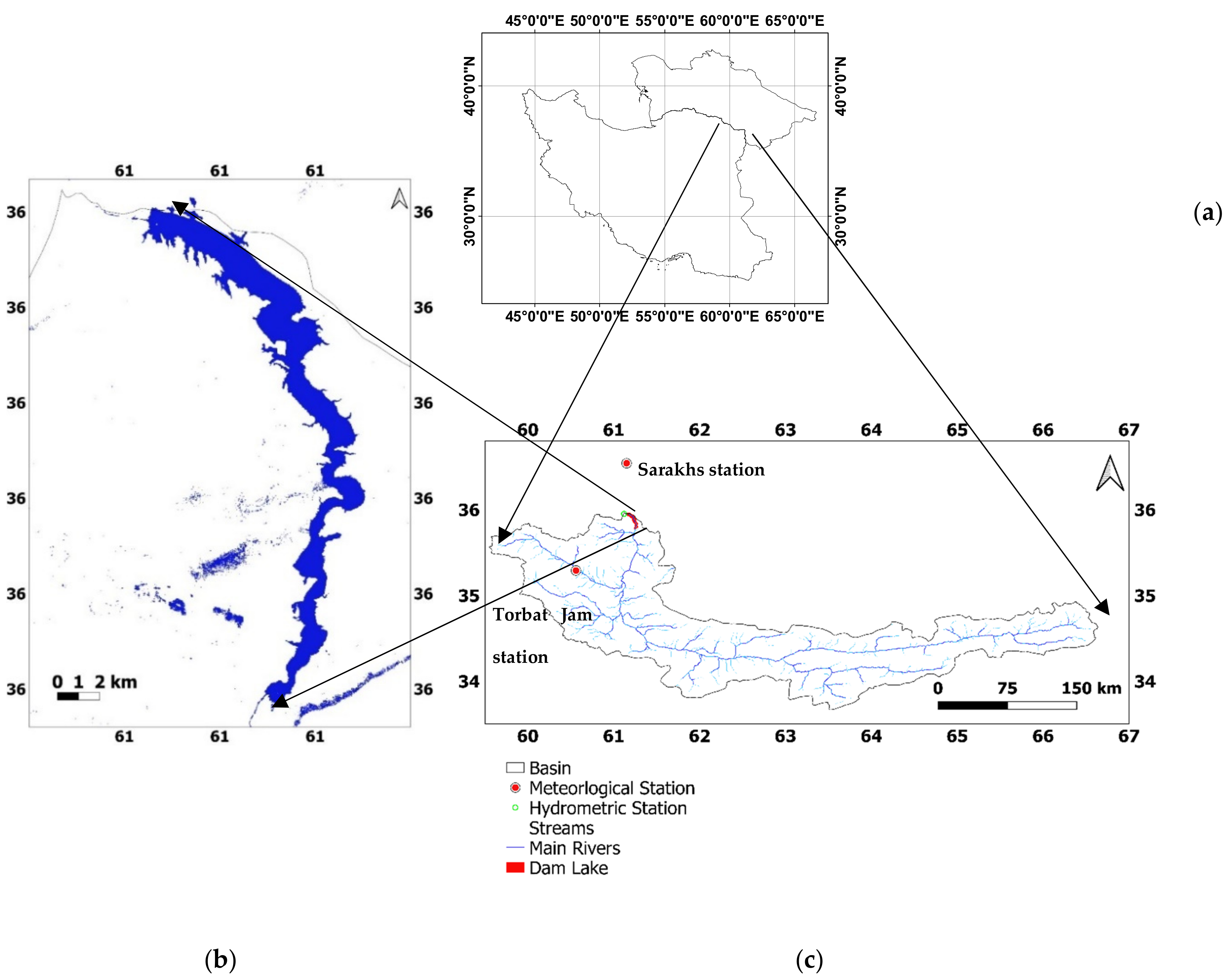
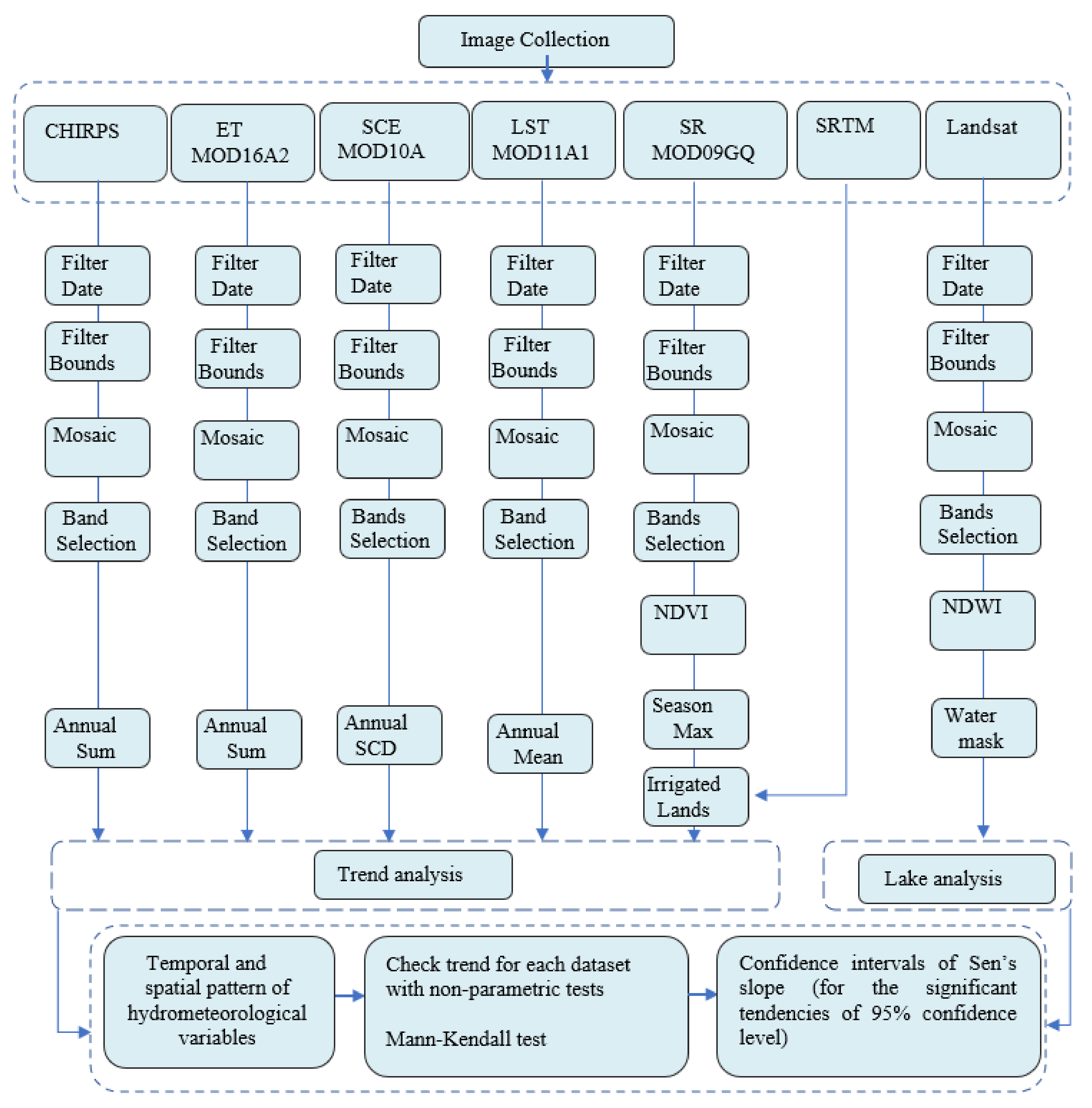



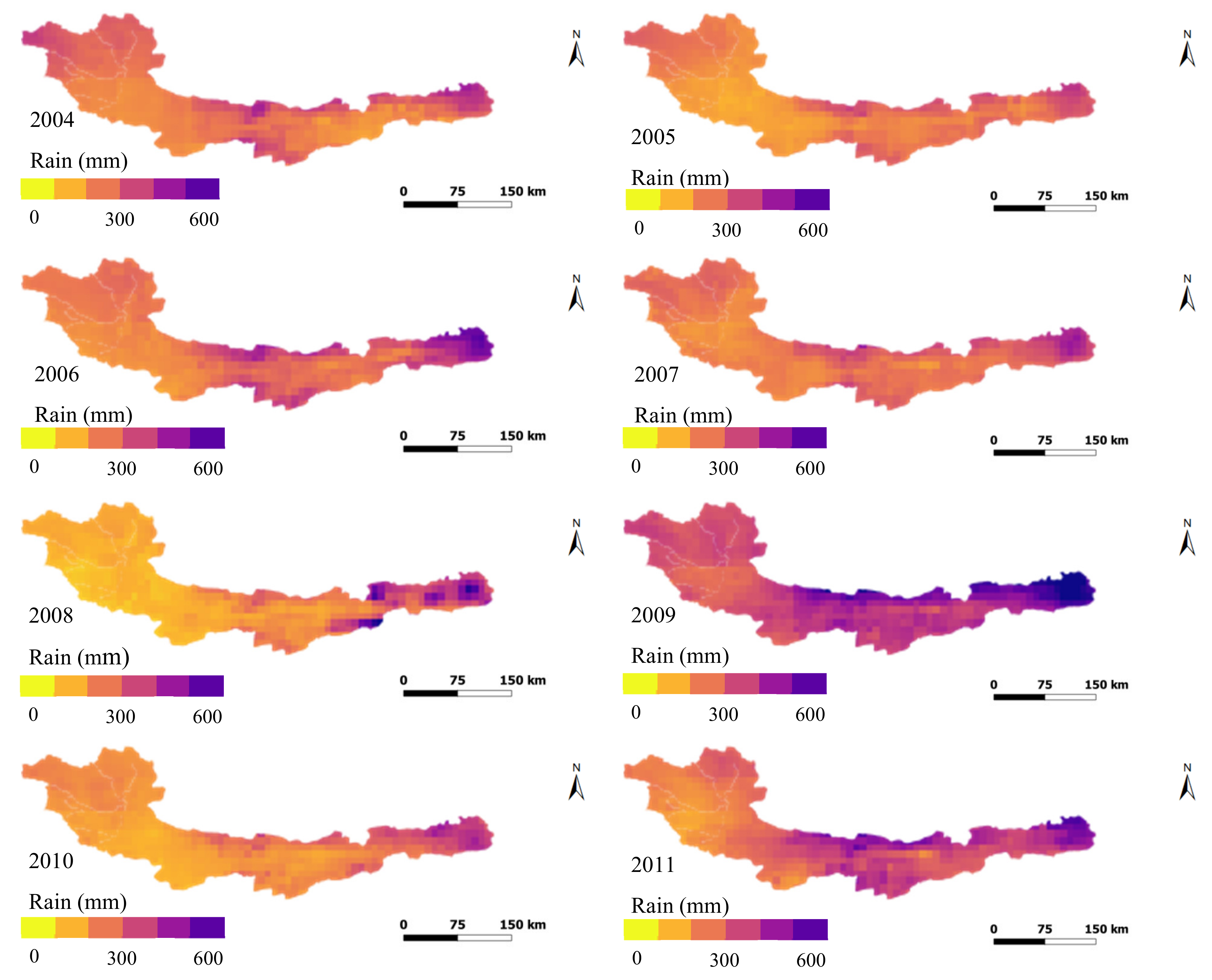
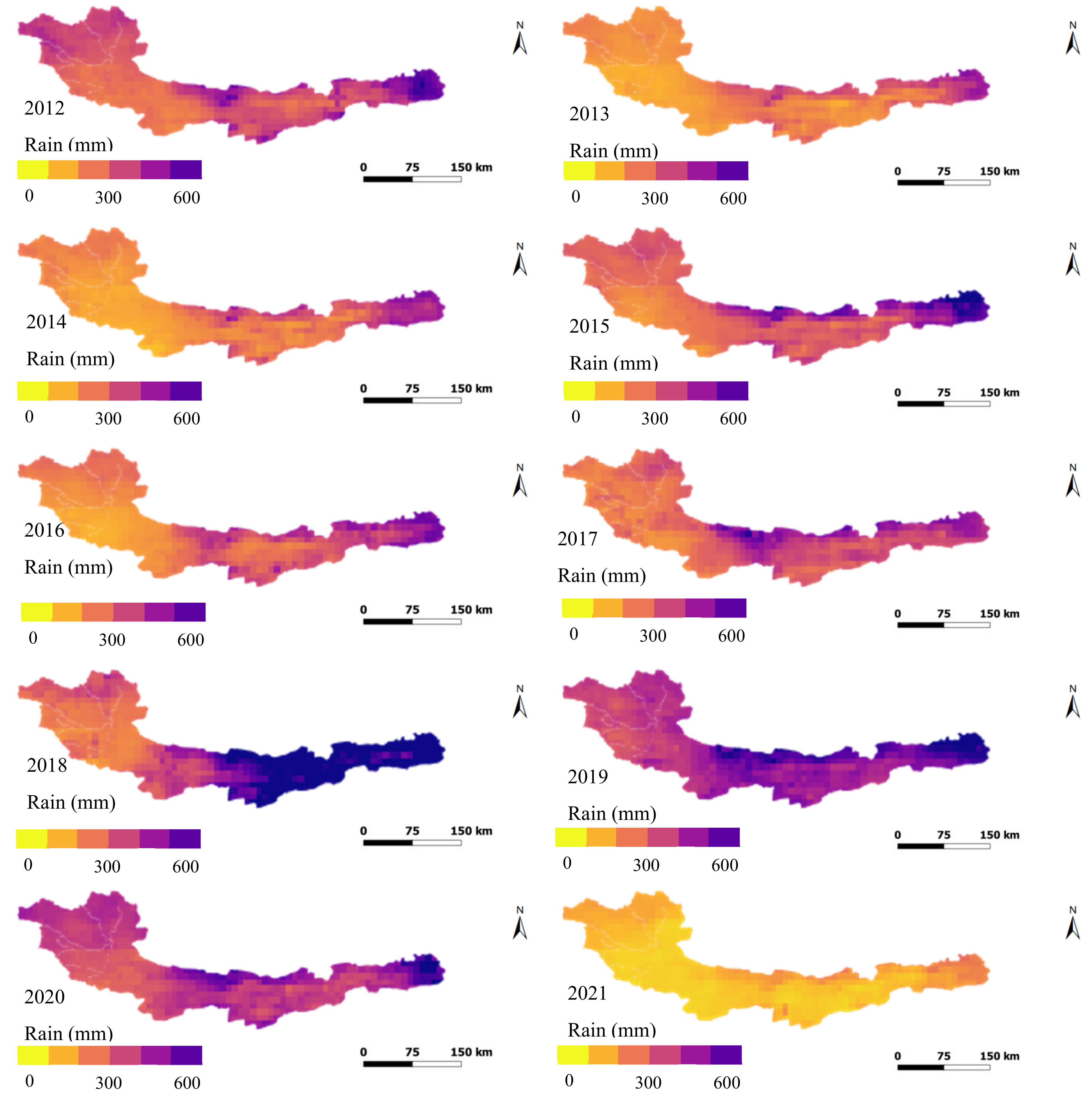

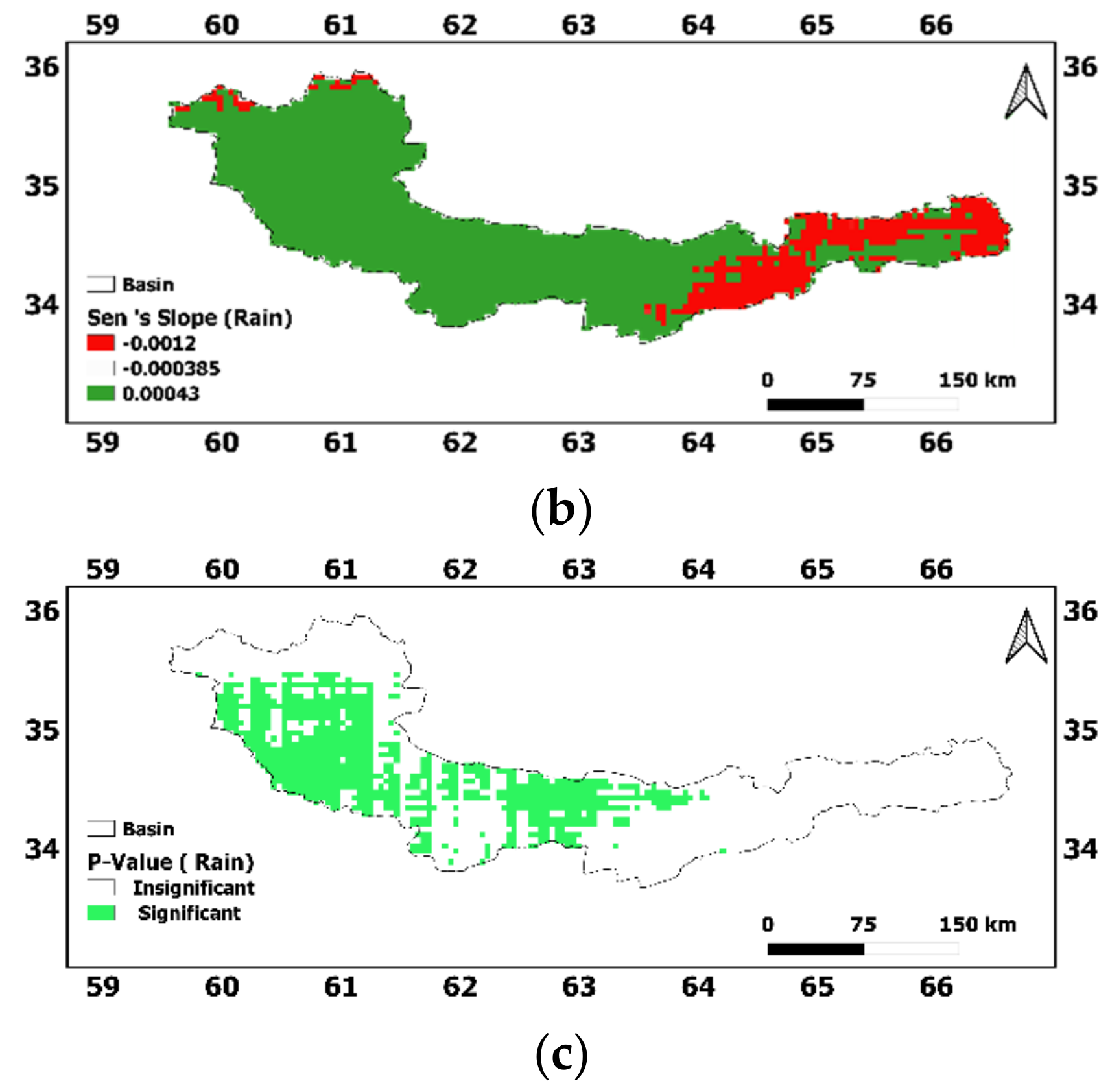




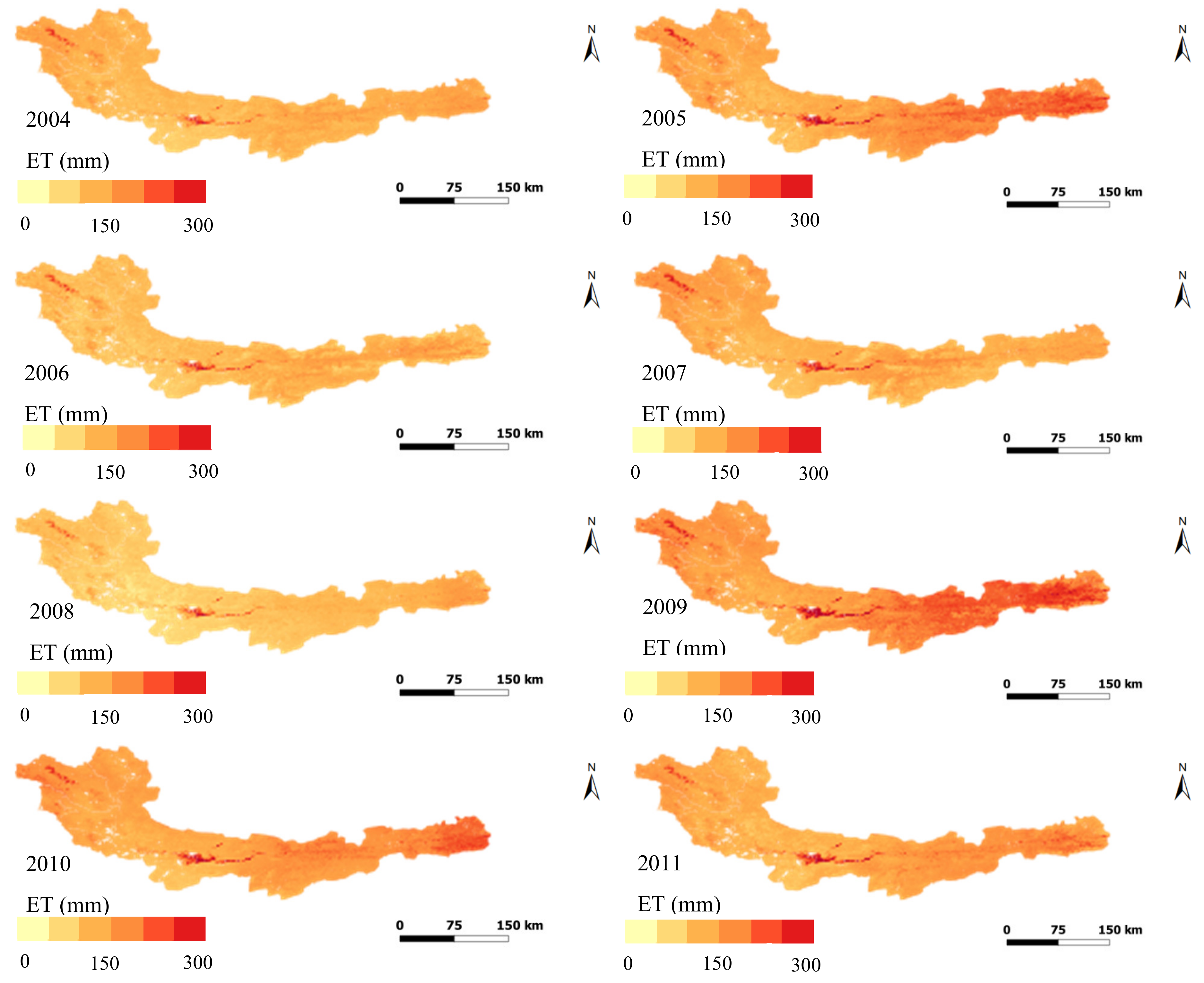

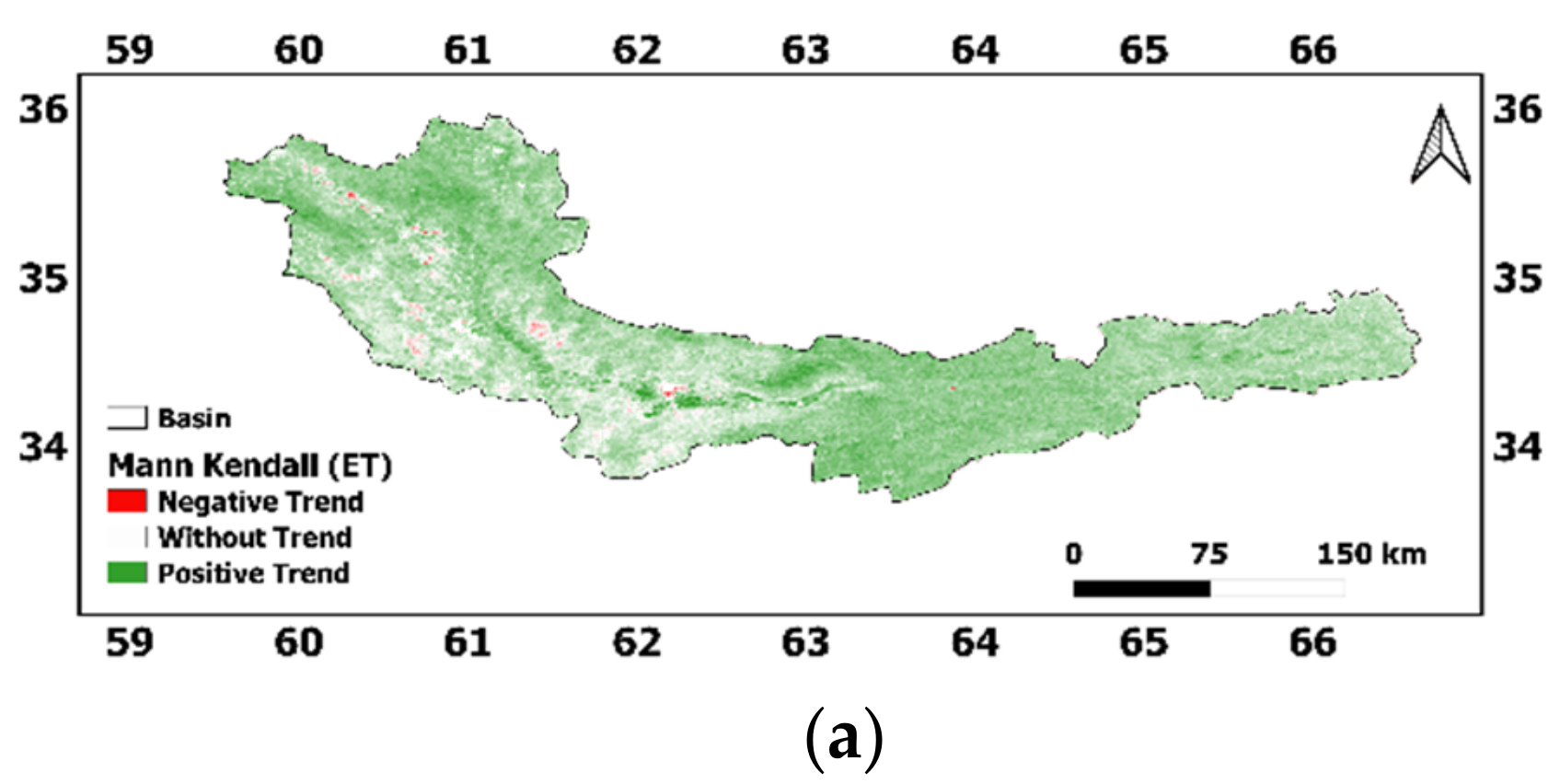
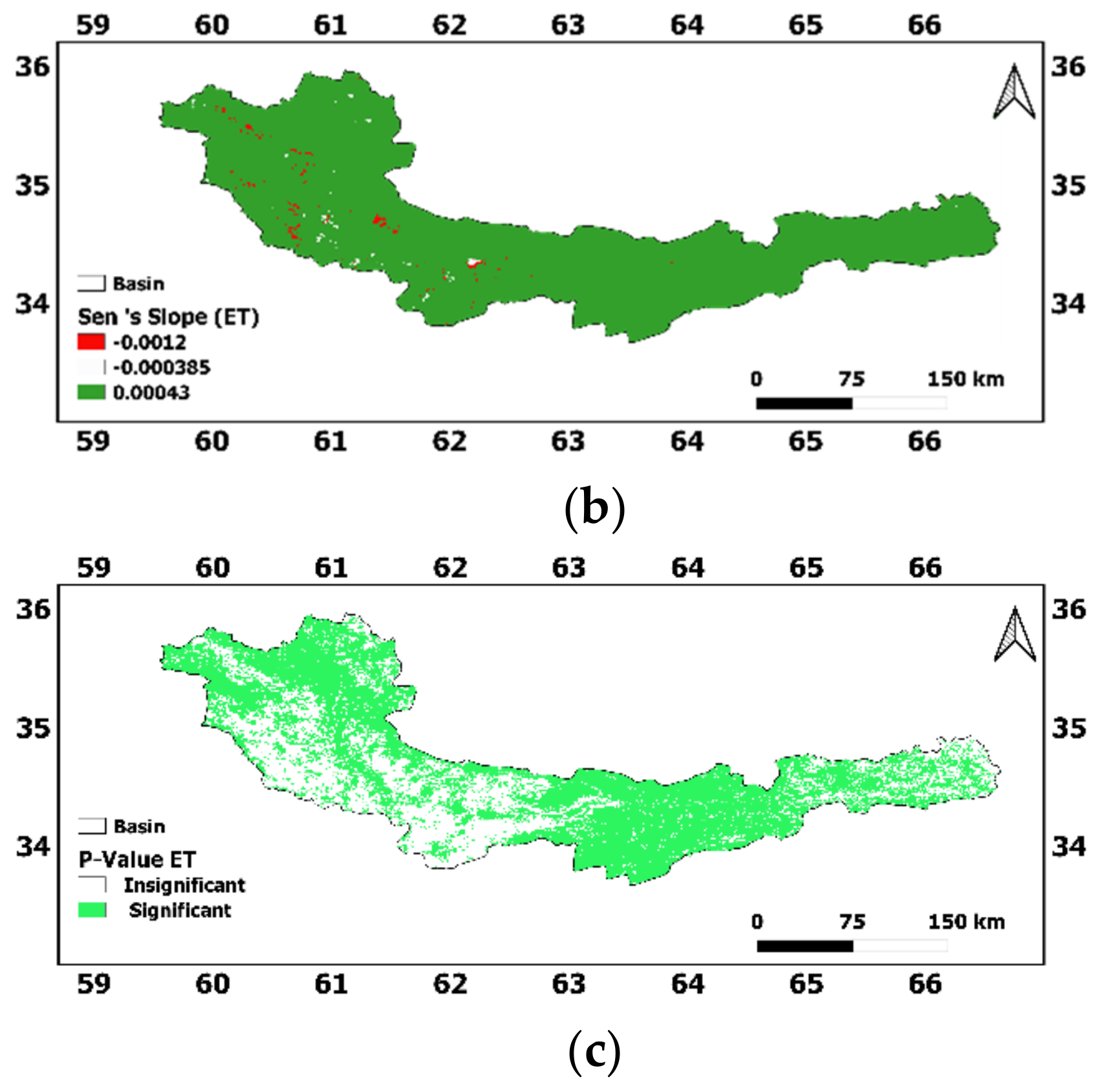



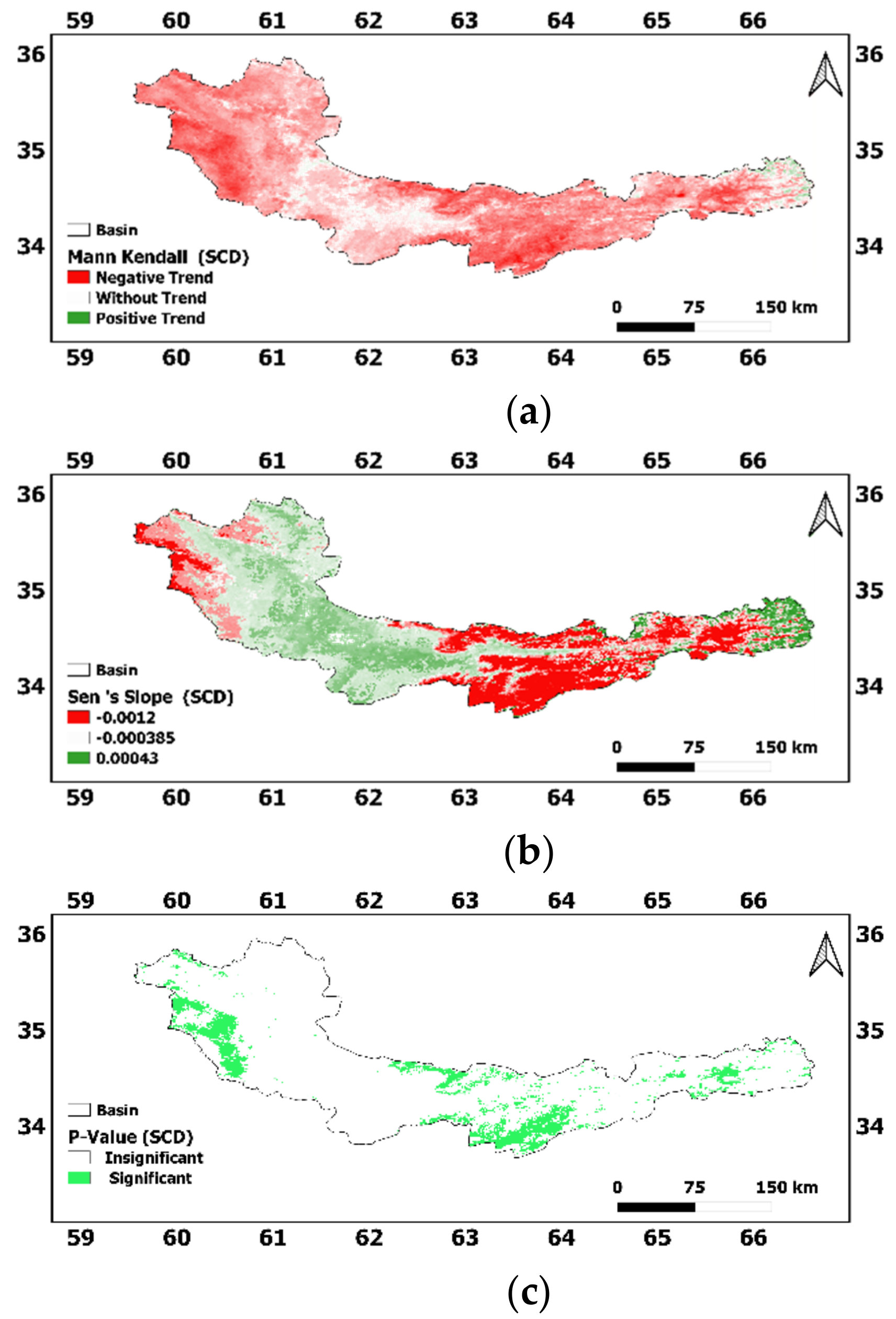
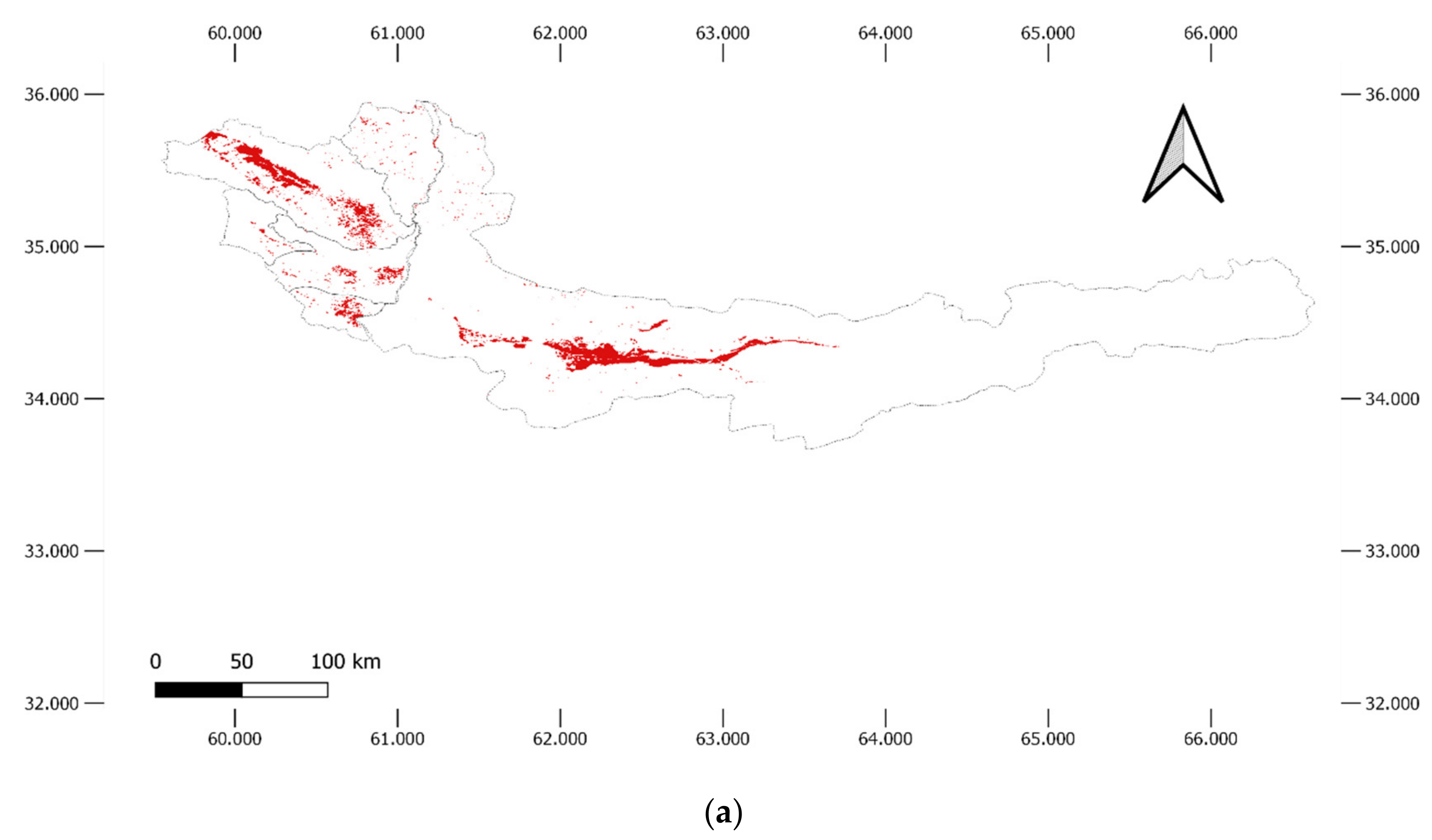

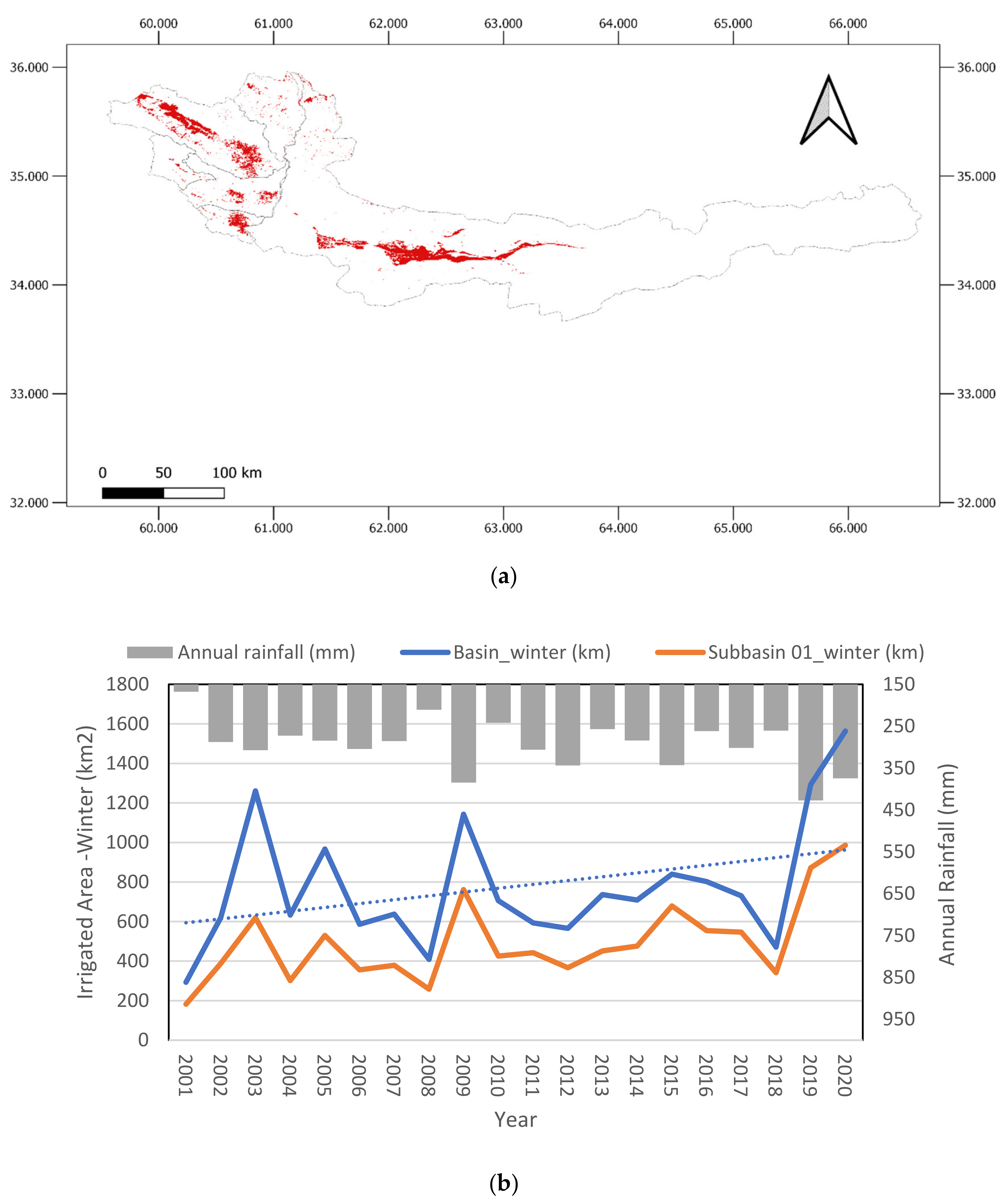
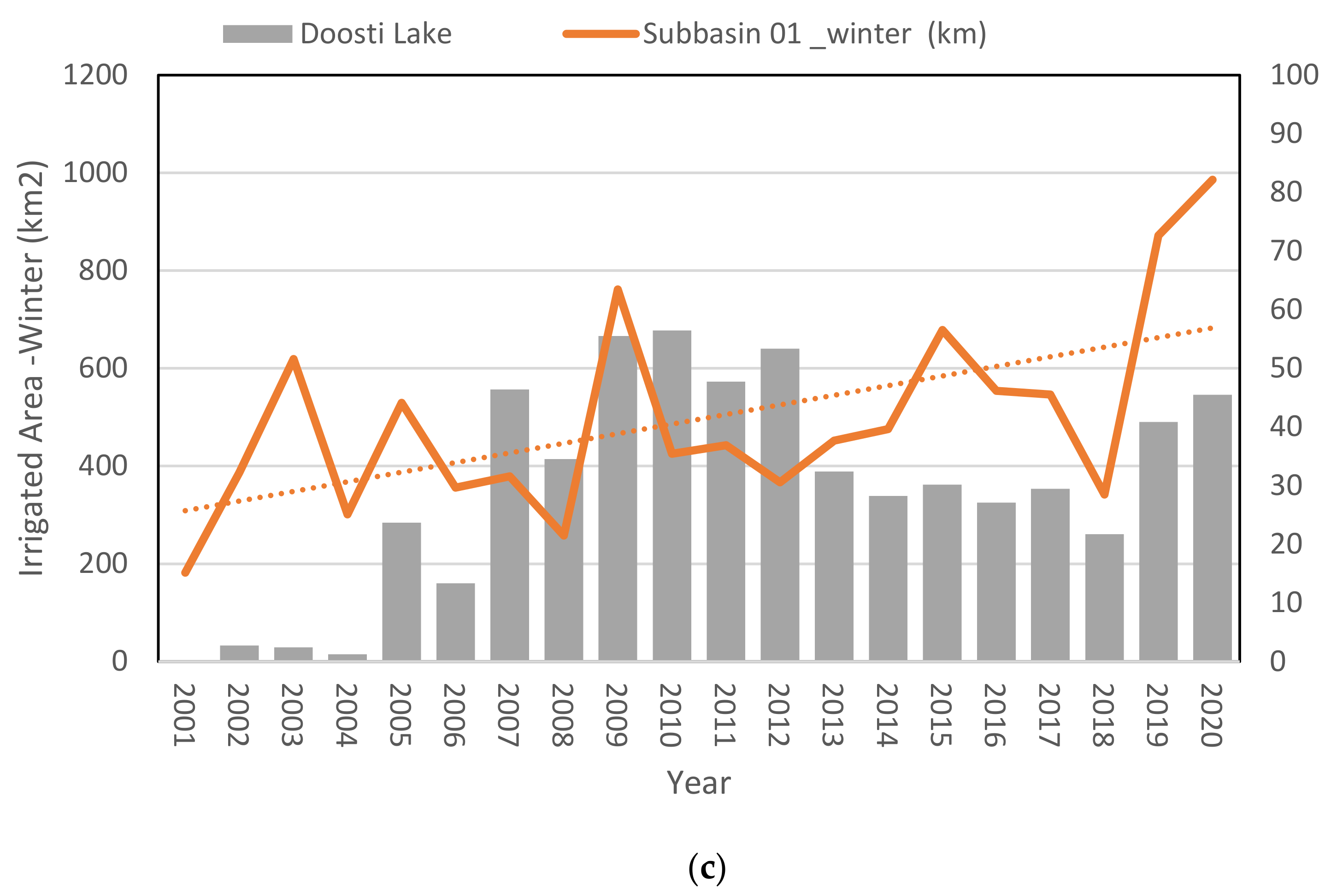
| Station | Specifications | Longitude (m) | Latitude (m) | Elevation (m) | Time Scale | Period |
|---|---|---|---|---|---|---|
| Torbat Jam | Meteorology station | 60.56 | 35.29 | 950 | Daily | 2001–2020 |
| Sarakhs | Meteorology station | 61.15 | 36.54 | 278 | Daily | 2001–2020 |
| Statistical Measurements | Rainfall Station (mm), Sarakhs | Rainfall Station (mm), Sarakhs | Rainfall Station (mm), Sarakhs | Rainfall Station (mm), Torbat | Rainfall Station (mm), Torbat | Rainfall Station (mm), Torbat | Temperature Station (°C), Sarakhs | Temperature Station (°C), Torbat |
|---|---|---|---|---|---|---|---|---|
| CHIRPS | GPM | ERA5 | CHIRPS | GPM | ERA5 | LST | LST | |
| R2 | 0.71 | 0.74 | 0.56 | 0.77 | 0.71 | 0.73 | 0.61 | 0.66 |
| Pearson’s correlation | 0.85 | 0.86 | 0.75 | 0.88 | 0.84 | 0.85 | 0.77 | 0.81 |
| RMSE | 25.27 | 34.28 | 35.59 | 48.57 | 49.23 | 66.16 | 4.56 | 9.25 |
| Bias | 5.6 | 19.7 | −2.36 | 40.40 | 37.55 | 59.12 | 4.44 | 8.75 |
| MBias | 1.02 | 1.13 | 0.98 | 1.31 | 1.23 | 1.45 | 1.16 | 1.32 |
| Parameters | Temporal Resolution | Product Information | Spatial Resolution | Time Period |
|---|---|---|---|---|
| CHIRPS | Daily | Climate Hazards Group InfraRed Precipitation with Station Data (Version 2.0 final) | 5 km | 2001–2021 |
| GPM | Daily | Global Precipitation Measurement (GPM) | 10 km | 2001–2020 |
| ERA5 | European Centre for Medium-Range Weather Forecasts (ECMWF) Climate Reanalysis | 25 km | 2001–2020 | |
| MODIS Terra | Daily | Surface reflectance (MOD09Q) | 250 m | 2004–2021 |
| Daily | Snow cover (MOD10A1) | 500 m | ||
| Daily | Land Surface Temperature (MOD11A1) | 1 km | ||
| 8-Day | Evapotranspiration (MOD16A2) | 500 m | ||
| Landsat 5 TM | 16 days | Level 1 | 30 m | 2004–2021 |
| Landsat 7 ETM | 16 days | Level 1 | 30 m | 2004–2021 |
| Landsat 8 OLI | 16 days | Level 1 | 30 m | 2013–2021 |
| DEM | 1 | SRTM | 90 m | - |
Publisher’s Note: MDPI stays neutral with regard to jurisdictional claims in published maps and institutional affiliations. |
© 2022 by the authors. Licensee MDPI, Basel, Switzerland. This article is an open access article distributed under the terms and conditions of the Creative Commons Attribution (CC BY) license (https://creativecommons.org/licenses/by/4.0/).
Share and Cite
Pakdel-Khasmakhi, H.; Vazifedoust, M.; Paudyal, D.R.; Chadalavada, S.; Alam, M.J. Google Earth Engine as Multi-Sensor Open-Source Tool for Monitoring Stream Flow in the Transboundary River Basin: Doosti River Dam. ISPRS Int. J. Geo-Inf. 2022, 11, 535. https://doi.org/10.3390/ijgi11110535
Pakdel-Khasmakhi H, Vazifedoust M, Paudyal DR, Chadalavada S, Alam MJ. Google Earth Engine as Multi-Sensor Open-Source Tool for Monitoring Stream Flow in the Transboundary River Basin: Doosti River Dam. ISPRS International Journal of Geo-Information. 2022; 11(11):535. https://doi.org/10.3390/ijgi11110535
Chicago/Turabian StylePakdel-Khasmakhi, Hadis, Majid Vazifedoust, Dev Raj Paudyal, Sreeni Chadalavada, and Md Jahangir Alam. 2022. "Google Earth Engine as Multi-Sensor Open-Source Tool for Monitoring Stream Flow in the Transboundary River Basin: Doosti River Dam" ISPRS International Journal of Geo-Information 11, no. 11: 535. https://doi.org/10.3390/ijgi11110535
APA StylePakdel-Khasmakhi, H., Vazifedoust, M., Paudyal, D. R., Chadalavada, S., & Alam, M. J. (2022). Google Earth Engine as Multi-Sensor Open-Source Tool for Monitoring Stream Flow in the Transboundary River Basin: Doosti River Dam. ISPRS International Journal of Geo-Information, 11(11), 535. https://doi.org/10.3390/ijgi11110535











